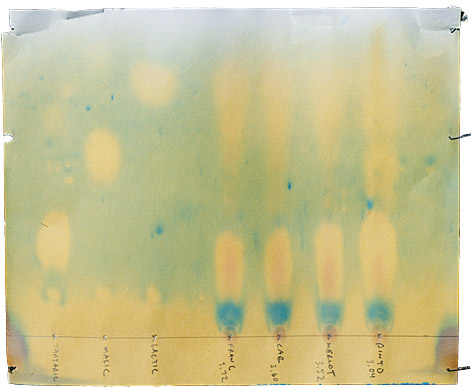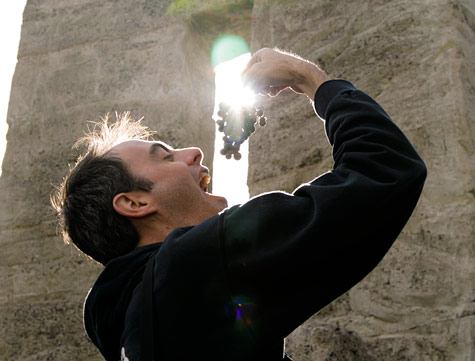2010 Update: the pretty damn good
As promised in a few days ago, here’s the next installment of how our 2010 wines are faring. We begin with dessert: the wines that really seem like they’ll be excellent — assuming we let them make it to bottle and don’t gleefully guzzle them right now.
Cabernet Franc
We like to rack the Franc only two or three times over the year, supposing that minimal handling will help preserve its bewitching aroma. One of those rackings was a few weeks ago, and like a saucy mermaid, it beckoned us with a irresistible floral nose, and then lured us ever-further into the depths with succulent, floral fruit. Wow. Once again, this will be both hard to blend away and deservedly form the backbone of the Peugeot.
Syrah
I’ve opened two 2009 Syrahs in the last couple of weeks, and holy crap, this is the most adult wine I think we’ve ever made: deep and powerful but unmistakably syrah (vs. liquid oak with varietal flavoring, as many are). The 2010 looks to be a good follow-up, but with better acidity and rich, crisply-articulated fruit resonating through great depth. Awesome.
Grenache
This is the first year we’ve tried Grenache, and typical of our sober, judicious approach to winemaking, we blindly hurled ourselves over the edge, investing heavily. Luckily, it paid off: when we racked it about a month ago, its aroma was as bewitching as the Franc’s, but more luscious and Provençal-herby. Thankfully, we’ll have enough to bottle separately and cast in our first Côtes-du-Rhône blend this year. It’ll be one stunning leading lady in that road show.
Mourvedre
We pressed this varietal into service for the first time this year as the third leg of a Côtes-du-Rhône stool, but to our suprise, it stands on its own just fine, thank you. Inky dark, and redolent of pepper and roses. Holy moley.
Pinot Noir
After three vintages working with fruit from a highly reputed Dundee Hills vineyard, our Pinot this year is finally beautiful — if willowy. Since this varietal totally ate our lunch in the 90s, we’ve been pretty gun-shy about it: as with white wines, its essential delicacy means there are fewer places to hide crappy fruit or bad winemaking, both of which we had in ample supply back in the day. As a result, for the last few years we’ve only produced small batches as “side-bets” for the braver Garagistes.
This year, I’m proud to report, it looks like that bet will pay off, in part because we’re better winemakers, but more importantly, because we’re working with better fruit. Of course, 2010 was a lighter vintage in Oregon — no Parker wines this year without heavy manipulation — and our Pinot is no anomaly. But it’s not watery or bland. It’s just… elegant, with beautiful, focused fruit. We put a little oak on it a month ago (just a little), so by the time we bottle it in September, it ought to be really lovely.
No commentsCabernets this weekend
I got word from our other grower that this weekend the fruit’s coming off his vineyard, ready or not. It’s been a difficult year for him, as it has for a lot of growers in the region: late fruit set in the spring means late ripening in the fall, and this grower is feeling that especially.

I’m still waiting for numbers from him, but I’ll be heading east on Saturday or Sunday to pick up Cabernet Sauvignon and our treasured Cabernet Franc. Late though it may be, I’m hoping we get the same luck we got with Westrey’s Oracle Pinot this year – not jammy ripe, but physiologically ripe, that special interlocking sensation when everything’s in balance and the fruit lasts and lasts on your tongue. Some of that’s due to extra hang time during cool fall nights, which keeps the acid intact even as ripeness progresses during the day. We’ll know soon enough!
In other news, the syrah is mighty happy to see us. So happy, in fact, that it’s overflowing its fermenter. In the interest of retaining thermal mass (the same principle as huddling together for warmth, I’d guess), I decided to divide one of the extra 30-gallon fermenters of syrah between another 30-gallon and the stainless steel tank. Was it close to the top? Oh, sure, a little, but what could go wrong? Now I know.
No commentsFranc rises from the dead
Last Wednesday night, I finally had a chance to rack the Franc and add both some sulfite and some acid in an attempt to resuscitate our young friend. My targets were about 50ppm free SO2, and dropping the pH by a tenth.
On Saturday night, Garagiste James was by, so we tried it for the first time since I’d racked it. I’m happy to report it’s definitely better — more alive, better fragrance, crisp, delicious fruit. That said, it’s still a little closed, which isn’t surprising considering it was bludgeoned with SO2 only days ago.
My plan is to re-taste it mid-week to see if it’s any better after a week of recuperation. If not, we may need to push blending trials back. More soon.
1 comment2007 Chroma results
 With fresh reference samples of some acids to work with, I put all four wines through paper chromatography yesterday [what the heck is “paper cro-magni-wha…?”: more background here]. Bask in the aurora borealitic results above.
With fresh reference samples of some acids to work with, I put all four wines through paper chromatography yesterday [what the heck is “paper cro-magni-wha…?”: more background here]. Bask in the aurora borealitic results above.
To the left, along the baseline and on top of those tiny X’s, I placed drops of tartaric, malic and lactic acid, spaced about an inch apart. You’ll note that directly above them there are balloon-like blobs, some closer to the baseline, others closer to the top of the page. If a wine has any of those acids in it, we’d expect to see a blob about the same distance up the page above its X. Crude? Yes. Beautiful? Oh, yeah.
So take a look at the blobs to the right, above drops of the Franc, Cab, Merlot and Pinto. Drawing a horizontal line from the reference blobs on the left, you can see that all of our wines have tartaric acid (not surprisingly), and all have lactic acid. That the Franc, Cab and Merlot don’t have a blob at the malic latitude suggests that all the malic acid in those wines has been converted to lactic acid, so we can assume that malolactic fermentation has finished. Or, in non-science speak, these wines are done fermenting and are more or less safe to bottle without risk of further CO2 bubble production, popping corks down the line and embarrassing Garagistes at parties.
On the far right, however, the Pinto does show some kind of blob at the malic level, though it’s not especially distinct. I took the pH of all our wines prior to running the test (you can see those numbers next to the names), and the Pinto was just a hair above 3, which is pretty acidic (the typical range of wine hits between 3.3 and 3.6). So my guess would be that that much acid has inhibited malolactic fermentation, slowing its progress through this wine. That said, I remember the Pinto tasting great (and not “acidic”), so I’m not sure what to make of or do with this result. Is malo stuck, or simply taking its time? Dunno.
In any case, the reason I ran the test in the first place is for the Franc, whose results indicate malolactic is over and we can therefore trust the acid numbers we got earlier. So in the next day or so, I’ll be adding SO2 and some acid to try to perk up our old friend.
1 commentFranc-ly Puzzling
As I wrote a few days ago, the Cabernet Franc — long our favorite wine from our grower — wasn’t its usual self at last racking. While it’s been dependably fresh and lovely any time we pull it from barrel, last week it was dull and flat, seemingly absent the will to live. A little unsettling, to say the least.
Today I got back some lab results from our long-suffering friends at ETS Labs, so we have a better picture of what’s going on with this sullen teenager. But even as the data answers some questions, it raises some others.
Stroke your beard and consider a theory or two with me after the jump…
Read more
The 2007 at June racking
 A few nights ago we got together to rack our three wines, and of course, couldn’t help tasting them as they poured from barrel to tank and back into barrel.
A few nights ago we got together to rack our three wines, and of course, couldn’t help tasting them as they poured from barrel to tank and back into barrel.
2007 Cabernet Franc
I think the consensus was that contrary to any of our previous experiences with this wine at this stage, the Franc showed the worst of the three. It had a decent fragrance, but it was murky and lifeless in the mouth, oddly framed with a hint of oak (it’s in an essentially neutral barrel). And once past the tonsils, it was like it was never there. Overall, a far cry from the fresh, precocious party-in-your-mouth the Franc usually is — and the way it was in March, when last we racked it.
So, what’s going on? Theories abound — more in a future post — but it’s certainly true that most wines go through “dumb” or hibernative stages, where between one chemical state and another they’re kind of in limbo. I think of it like a construction project: you begin with one thing (nice bones, but what Nazi scientist designed that wallpaper!?), but before the shiny new thing emerges (did you notice it matches my iTouch?), you float like Dante through the undoing of one and the creation of the other, where your thing isn’t what it was, but it isn’t what it’ll become. It’s something, yet it’s also not quite anything, either. And you have to use a port-a-potty in the back yard for a month.
Anyway, that’s not unusual for wine as it evolves (for example, see my notes on the Sauvignon, below), but it’s not how the Franc has ever performed in the past. More soon.
Cabernet Sauvignon
Next up was the Cab. It was also a little shuttered, but more in a way you’d expect at this stage in its life. All the stuffing was there, and indeed, it had a lot of complexity and good feel in the mouth, though not much of a finish that night. All in all, however, showed pretty good life for so young a wine, and all present murmured approval into their cups.
Merlot
If you’ve got a weak heart, please skip the second half of this sentence: the merlot was the best wine of the evening. I’ll give you a minute to get your bearings. Sometimes a glass of wine helps.
While it lacked a little backbone (though in point of fact, it showed the backbone of a good Merlot), it betrayed surprising life, in addition to a bass marimba-like depth and velvetyness in the mouth. Almost complex, and a pretty good ride through the finish.
If this is in fact representative of where the Merlot will end up (no guarantees there, of course), I’d say this is due to a combination of three things: 1) wild yeast (so many gene pools, so many flavors); 2) crop load (we asked the grower to dramatically reduce yield in 2007: and 3) pulling a seignée out of it (in a nutshell, a seignée drains juice from a fermenter, increasing the proportion of flavor-packed skins to tasty juice). I’d give more of a nod to 2 and 3 than 1, but probably all played a role.
Next up is blending, so we’ll see if this was an aberration or a strategy worth repeating.
No commentsThe rack: March edition
 Last week’s racking proceeded with our characteristic machine-like efficiency – when we used our machines, that is.
Last week’s racking proceeded with our characteristic machine-like efficiency – when we used our machines, that is.
The Cabernet Sauvignon continues to shine. Great fruit, good tannins which are getting better with every racking (I’ll bet from the wood — see here for our oak strategy this year), transporting aromas of pencil shavings and saddle. This one’s going to be the best Cowan by far.
Next up was the Merlot. It seemed its usual, uncomplicated and amiable self at first, but lurking around the periphery — like the sense you get walking into a familiar room which looks empty, but has someone else inside — was an off odor. It’s a slight tint of VA (or volatile acidity, which betrays a lovely smell of fingernail polish), but there was also a hint of vegetation. A bit of veg can be typical of Merlot’s flavor profile, but this felt ever so slightly beyond that. After racking, everything seemed fine – no VA, no significant veg, and nice fruit. I measured the free SO2 at about 65, which seems safe enough, so no further additions. We’ll want to keep an eye on this one, though.
Lastly, we tasted the Cabernet Franc, which seemed just fine where it was — good, approachable structure, lovely, bright fruit. So we decided to simply top the barrel and leave the racking for the next go-around in April.
No comments
